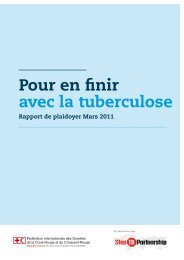Thailand - Stop TB Partnership
Thailand - Stop TB Partnership
Thailand - Stop TB Partnership
You also want an ePaper? Increase the reach of your titles
YUMPU automatically turns print PDFs into web optimized ePapers that Google loves.
through standard microscopy. The lack of reliable diagnostic tools results in missed cases<br />
and higher mortality as well as mistreatment of non-<strong>TB</strong> cases in some instances. 12<br />
A two-year survey conducted in collaboration with the WHO from 1996 to 1998<br />
recorded primary MDR-<strong>TB</strong> prevalence at 2.57 percent nationally. 13 However, according to the<br />
WHO, primary MDR-<strong>TB</strong> prevalence was estimated to be just 0.9 percent as of 2004. 14 Some<br />
Thai experts express concern that MDR rates could be higher among vulnerable groups,<br />
including the urban poor, prisoners, seasonal contract workers, and migrants. 15<br />
Health system infrastructure<br />
<strong>Thailand</strong> has a strong public health infrastructure. Basic medical services and facilities are<br />
relatively easy to access through government-financed hospitals and over 9,000 primary<br />
health care centers. 16 The public sector finances approximately 57 percent of total annual<br />
health expenditures.<br />
NTP implementation is overseen by the “<strong>TB</strong> Cluster,” which is located within the<br />
Bureau of HIV/AIDS, <strong>TB</strong> and Sexually Transmitted Infections (STIs). The <strong>TB</strong> Cluster is<br />
responsible for developing and planning <strong>TB</strong> policies, training health workers, and monitoring<br />
<strong>TB</strong> control activities throughout the country. <strong>TB</strong> diagnostic and treatment services are<br />
provided through a network of provincial and district level hospitals and clinics.<br />
<strong>Thailand</strong> also has an extensive network of private health facilities. According to<br />
one recent study, an estimated 20–40 percent of <strong>TB</strong> cases are treated in the private sector. 17<br />
Private practitioners generally do not observe NTP guidelines, and treatment for their <strong>TB</strong><br />
patients is most often self-administered, rather than administered and observed by a clinician.<br />
Most private facilities do not offer services available in public clinics, such as HIV<br />
testing, standardized <strong>TB</strong> and HIV treatment regimens, and routine monitoring of patients. 18<br />
Few private facilities perform cultures and drug sensitivity testing. 19<br />
PUBLIC HEALTH WATCH MONITORING REPORTS 39


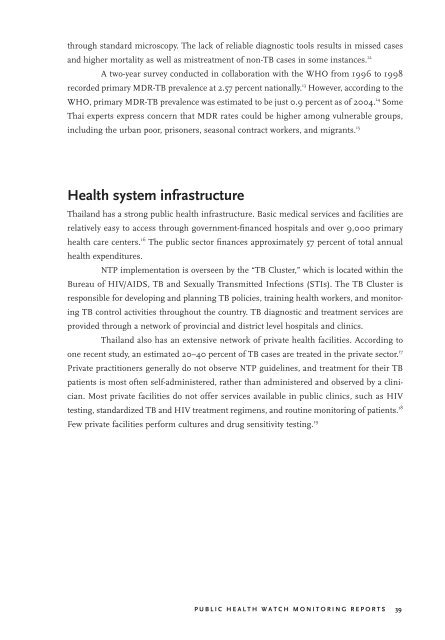
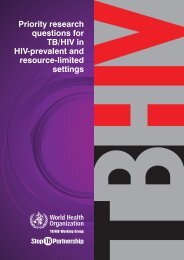
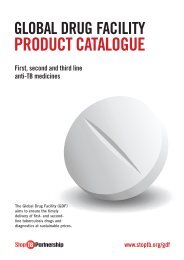
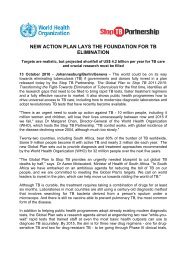
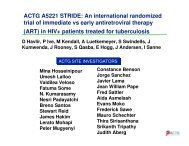
![Global Drug Facility Annual Report 2011 [.pdf] - Stop TB Partnership](https://img.yumpu.com/26788745/1/184x260/global-drug-facility-annual-report-2011-pdf-stop-tb-partnership.jpg?quality=85)

![Concept note on national stop TB partnership [.pdf]](https://img.yumpu.com/26788741/1/184x260/concept-note-on-national-stop-tb-partnership-pdf.jpg?quality=85)
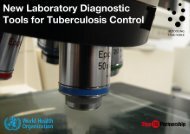

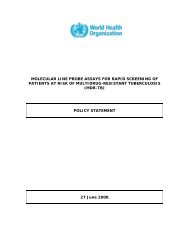
![2005 and Challenges for 2006 - 2015 [.pdf] - Stop TB Partnership](https://img.yumpu.com/26788674/1/190x245/2005-and-challenges-for-2006-2015-pdf-stop-tb-partnership.jpg?quality=85)
![Brochure (French) [.pdf] - Stop TB Partnership](https://img.yumpu.com/17234792/1/190x91/brochure-french-pdf-stop-tb-partnership.jpg?quality=85)

